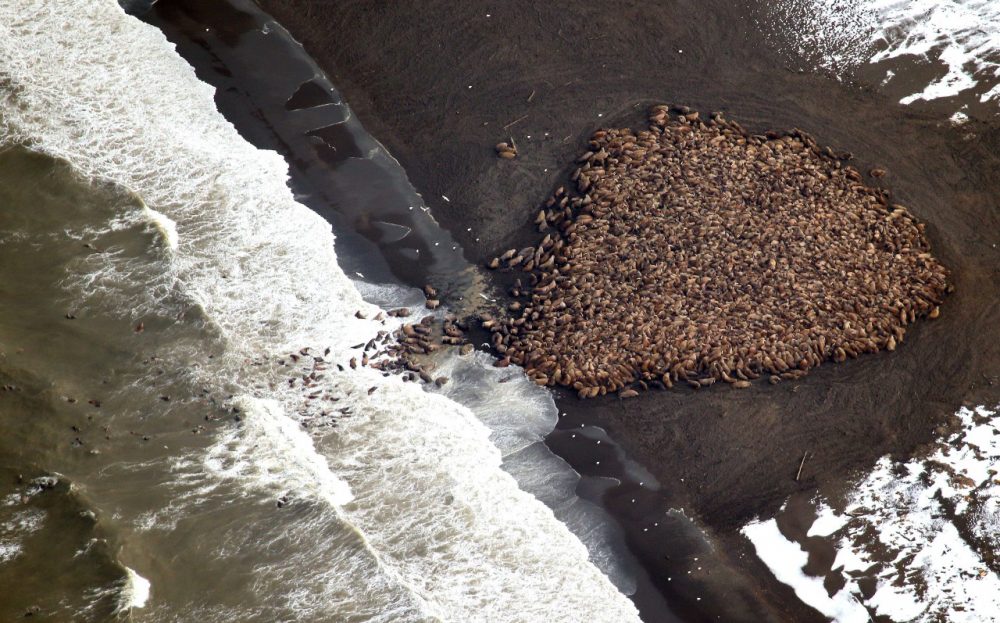 |
| Walruses on an ice floe |
The Center for Biological Diversity has recently stated that walruses are threatened after the Trump Administration refused to list them as "endangered" last month. The conservation group, which filed a lawsuit in 2008 to get the animals on the Endangered Species List, said that the government's decision has put the species in an ominous state as it meets the effects of climate change. According to Chad Jay, who leads the walrus research program at the U.S Geological Survey Alaska Science Center, the animals are dealing with loss of habitat due to melting of sea ice which they rely on for breeding, feeding, nursing, their young, and avoid predators. Although the U.S Fish and Wildlife Service (USFWS) recognized that sea ice is melting due to climate change, it denied that walruses are in danger of extinction, suggesting that that they will probably be able to adapt to their changing environment. However, even though the agency has estimated that there are almost 23,000 walruses left, it has indicated that there is some concern over the precise population numbers.
 |
| A gathering of about 35,000 walruses by NOAA's annual arctic marine mammal aerial survey |
The impact of climate change has and continues to tremendously affect the walruses through sea ice melting, particularly in late summer and early autumn. This is when sea ice shrinks to such a large extent that it does not cover the shallow areas that function as the animals' feeding grounds. Therefore, the walruses are forced to use land haul outs further away from their feeding grounds to rest between their feeding sessions. According to Lee Cooper, a research professor at University of Maryland's Center for Environmental Science, walruses are known to survive without food for a certain amount of time. But that does not mean they can survive on the long run. The decline in sea ice is a result of ocean warming and acidification. Acidification is known to threaten clams and mussels, which constitute the main diet of walruses thus affecting their survival. In addition, climate change has even affected the movement and behavior of walruses. While males come normally come ashore at certain times of the year, since 2007, researchers have sighted more females and their young on land than males. The younger walruses are vulnerable to being trampled to death when giant herds form on land. In September, roughly 64 youngsters less than a year old were found dead near Point Lay in Alaska. This indicates that walruses on land are prone to disturbance from factors ranging from polar bears and human activities. And it is therefore crucial to identify specific areas in the Arctic region where walruses are present and mark them as off-limits to the public, in order to reduce the impact of human activities.
.jpg/800px-Official_Portrait_of_President_Donald_Trump_(cropped).jpg) |
| The Trump Administration decided not to list walruses as endangered species much to the dismay of the Center for Biological Diversity |
It is equally essential that the U.S government should recognize the need to protect and preserve walruses and various species of Arctic wildlife under threat of climate change and global warming. The Trump Administration made a very shameful decision in refusing to recognize and list walruses as endangered species, despite the studies and research done by conservation groups like the Center for Biological Diversity. This indicates that the administration has very little to worry about the issue of climate change which not only harms harms the inhabitants of the Arctic, but also people and wildlife around the world. It does not matter what political party is in power or under whose presidency the U.S is functioning; the bottom line is that climate change and global warming should be taken seriously and essential measurements must be implemented to ensure the protection and well-being of people and wildlife around the world. In addition, acknowledging such environmental issues would put U.S in good terms with other countries and with various conservation groups on both national and international levels.
View article here
No comments:
Post a Comment